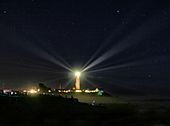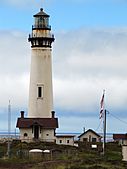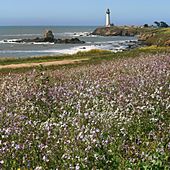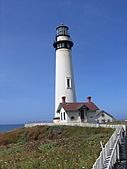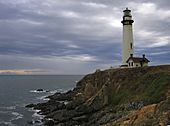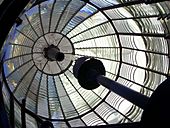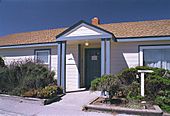Pigeon Point Lighthouse facts for kids
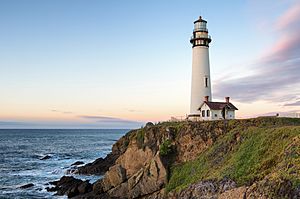 |
|
| Pigeon Point Lighthouse in 2016 | |
|
|
|
| Location | Pigeon Point southern to San Francisco Bay California United States |
|---|---|
| Coordinates | 37°10′54.3″N 122°23′38.1″W / 37.181750°N 122.393917°W |
| Year first constructed | 1871 |
| Year first lit | 1872 |
| Automated | 1974 |
| Foundation | stone |
| Construction | brick tower |
| Tower shape | tapered cylindrical tower with balcony and lantern attached to workroom |
| Markings / pattern | white tower, black trim |
| Height | 115 ft (35 m) |
| Focal height | 148 ft (45 m) |
| Original lens | First order Fresnel lens (1872) |
| Current lens | DCB-24 aerobeacon |
| Range | 24 nmi (44 km; 28 mi) |
| Characteristic | Flashing white 10s, Emergency light of reduced intensity when main light is extinguished. |
| Admiralty number | G4006 |
| ARLHS number | USA-499 |
| USCG number | 6-0320 |
The Pigeon Point Light Station, also known as Pigeon Point Lighthouse, is a tall lighthouse built in 1871. It stands on the Pacific coast of California. This lighthouse helps guide ships safely along the coast. It is one of the tallest lighthouses on the West Coast of the United States. The lighthouse is still used today by the United States Coast Guard to help ships navigate.
You can find Pigeon Point Light Station along State Route 1, a famous coastal highway. It is about 5 miles (8 km) south of Pescadero, California. The lighthouse is located between the cities of Santa Cruz and San Francisco. Its 115-foot (35 m) white brick tower looks a lot like lighthouses you might see in New England. Many people visit Pigeon Point because it's easy to reach from the main road.
The lighthouse and the land around it are now part of the Pigeon Point Light Station State Historic Park. This is a California state park. The lighthouse is also listed on the National Register of Historic Places. It is recognized as a special California Historical Landmark. You might even recognize the Pigeon Point Lighthouse! It is used as a logo for the E. W. Scripps Company.
Contents
History of Pigeon Point Lighthouse
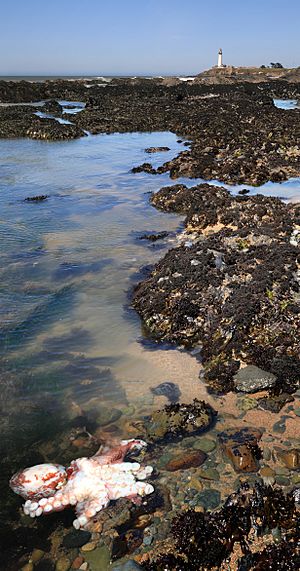
Pigeon Point Lighthouse is known for its beautiful views on the Pacific coast. The tower sits on a rocky point of land. For a long time, it has been an important landmark for ships heading towards San Francisco Bay from the south. The area, and the lighthouse, got its name from a ship called the Carrier Pigeon. This ship unfortunately wrecked here in 1853.
The Amazing Fresnel Lens
The very top of the lighthouse, called the lantern room, once held a special Fresnel lens. This was a first-order lens, meaning it was very large and powerful. It was made in Paris, France, by the Henry-LePaute company. This amazing lens had 24 flash panels. It was built with 1008 hand-polished lenses and prisms. When it was working, it could produce over 500,000 candlepower of light! The lens was first lit at Pigeon Point on November 15, 1872.
Originally, the lighthouse used a lamp that burned refined lard oil (pig fat). In 1888, this was changed to a kerosene lamp. The lens weighed one ton and rotated once every four minutes. This rotation made it look like the light flashed white every ten seconds from a distance. A clockwork system with a 45 pounds (20 kg) weight powered the lens rotation.
Modern Changes and Retirement
In 1926, the lighthouse got electricity. This was a big upgrade! The kerosene lamp was replaced with a powerful 1000-watt light bulb. An electric motor took over from the clockwork system. An electric fog signal was also installed.
The United States Coast Guard stopped using the original Fresnel lens for regular duty in 1972. They put a smaller, modern 24-inch (610 mm) aerobeacon on the front of the tower. The large Fresnel lens is no longer lit for special events. It was moved from the top of the tower in November 2011. Now, you can see it displayed in the fog signal building, which is next to the lighthouse. The smaller light on the tower today still helps ships navigate.
Tower Repairs and Hostel Life
The tower has been closed for tours since December 2001. This is because some of the brickwork supporting the metal walkways at the top became damaged. The walkways were made of cast iron, which can rust badly over time. The California State Park system plans to make repairs. It will take some time and money to fix it.
The old houses where the lighthouse keepers used to live have a new purpose. Since the mid-1960s, they have been a youth hostel. A non-profit group called HI USA runs the hostel. It helps young people from all over the world learn about different cultures. The four houses have rooms for groups and individual travelers. Guests share kitchens and living areas, which helps them meet people from other countries. There's even an outdoor hot tub you can rent in the evenings!
Image gallery
-
Pigeon Point Lighthouse with wildflowers (view from the South)
Images for kids






